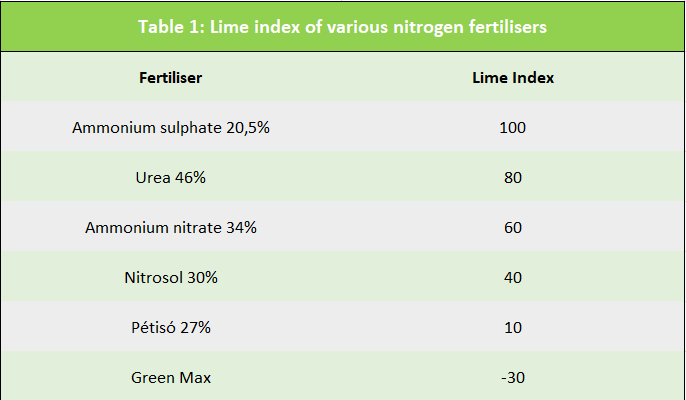PÉTISÓ (CAN)! PREMIUM QUALITY SINCE 1931, WITH A UNIQUE HIGH ACTIVE INGREDIENT CONTENT OF 39%!
2024. January 19., Friday
2024. January 19., Friday
Pétisó (calcium ammonium nitrate) is a solid lime ammonium nitrate (MAS, CAN) fertiliser manufactured since 1931. What makes it different from other preparations is that instead of lime (CaCO3), finely ground dolomite, which is the double salt of calcium carbonate (CaCO3) and magnesium carbonate (MgCO3), is mixed into the product. It has a nitrogen content of 27% though, including its 7% CaO and 5% MgO content, its total active ingredient content is 39%. Each 1 tonne of Pétisó contains 228 kg of soil improver (dolomite).
CaCO3 and MgCO3 are insoluble in water, but when combined with various acids (carbonic acid, soil acids, root acids and nitric acid) they become water-soluble compounds and can thus be absorbed by plants. To make that process easier, the dolomite is mixed into the fertiliser in a finely ground form.
The average particle size of the dolomite powder is 40 micrometres. Due to its dolomite content, it is especially effective in acidic soils, and through its calcium and magnesium content it improves the soil structure. It is especially recommended for fertilising magnesium-intensive crops - potatoes, sugar beet, perennial leguminous plants, maize, rapeseed, oats, horticultural plants and herbs! The dolomite in Pétisó increases the calcium and magnesium content of the soil, stabilising its pH.
There are many reasons for the development of soil acidity: climatic factors, the soil-forming rock, the topographic and hydrological conditions of the landscape, biological effects and last, but not least, anthropogenic effects. Man acidifies the soil with industrial pollution, calcium extracted with the crop and, particularly, through inadequate, unsuitable fertilisation.
Although high yields cannot be achieved without high-dose fertilisation, most fertilisers, directly or indirectly, acidify the soil. Of those, nitrogen fertilisers acidify most intensively. The acidifying effect of fertilisers is indicated by the lime index, which shows how many kilogrammes of calcium carbonate are required to neutralize the acidifying effect of 100 kg of fertiliser. The lower the lime index, the less acidification is caused by the given fertiliser.

It can be clearly seen that ammonium nitrate acidifies the soil six times more than Pétisó (Table 1). Pétisó (CAN) has a very low lime index so, with its regular use, sustainable nitrogen fertilisation may be achieved. It is advantageous that the dolomite that is a component of Pétisó, is local to the immediate vicinity of the resulting root acid, and that its fine particle size allows a rapid reaction. As a result, the structure of the soil improves, its ability to supply nitrogen and phosphorus, and its supply of micronutrients, increases, and soil life intensifies. Thus, a higher yield and better yield quality can be achieved. On acidic soils, 100 kg of Pétisó has a better effect than 100 kg of ammonium nitrate, despite the fact that the latter contains 7 kg more nitrogen! The nitrogen in Pétisó contains the same proportion of slower-acting ammonium nitrogen and fast-acting nitrate nitrogen, so it can be used as a basal, starter and top dressing on all soil types and crops.
Pétisó particles are formed in two ways. One process is granulation (granulated Pétisó), while the other is prilling (prilled Pétisó). The average typical particle size of the granulated Pétisó is 2.5–6.3 mm, that of the prilled one is 0.8–4 mm. The granular Pétisó has good temperature tolerance and an ideal particle size distribution. Due to its particle strength and size, it is also excellent for application with more modern, larger working width, fertiliser spreaders.
What soil should Pétisó be applied on?
It can be used on all types of soil, as a basal, starter or top dressing. It is the best choice in acidic areas, on sandy soils and on magnesium-poor fields, because it does not further acidify the soil, stabilises its pH, and replenishes calcium and magnesium.
When should granulated Pétisó be used?
Its slower water uptake and dissolution ensures a continuous supply of nitrogen and gives a good dispersion pattern even at spread widths greater than 24 m.
When should prilled Pétisó be used?
The water uptake rate of prilled Pétisó is higher than that of the granulated version - initially equal to that of ammonium nitrate. It therefore dissolves as efficiently as ammonium nitrate, making it an excellent choice for delayed top dressing. Due to its smaller particle size, more small particles per m2 are applied, which can result in a better distribution of the active ingredient and a good dispersion pattern up to 24 m spread width.